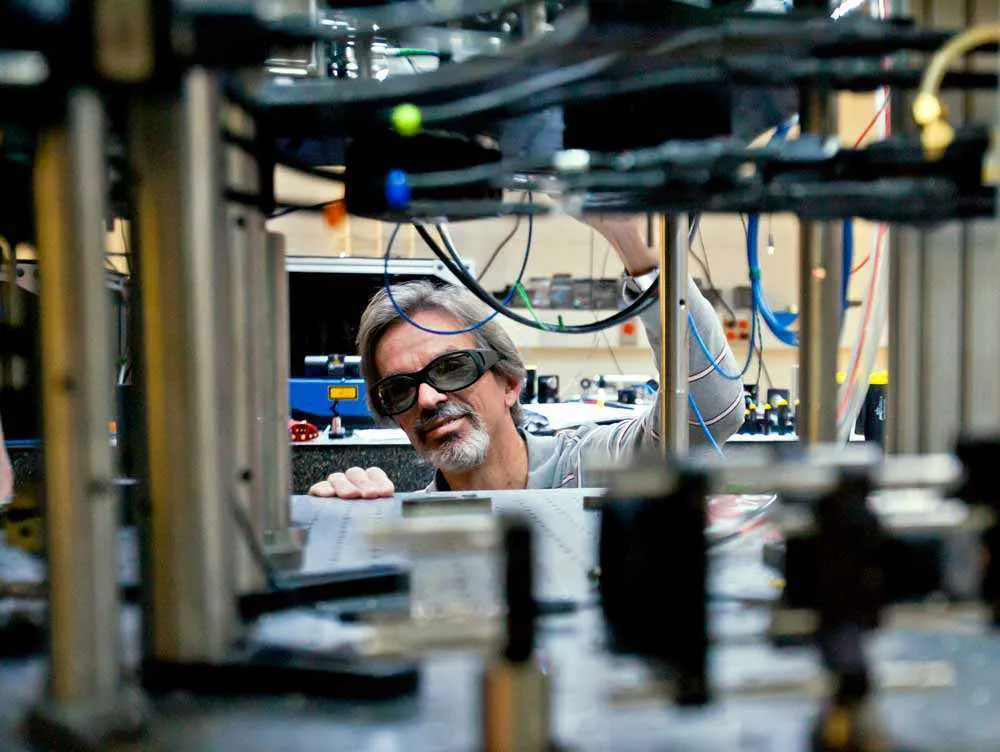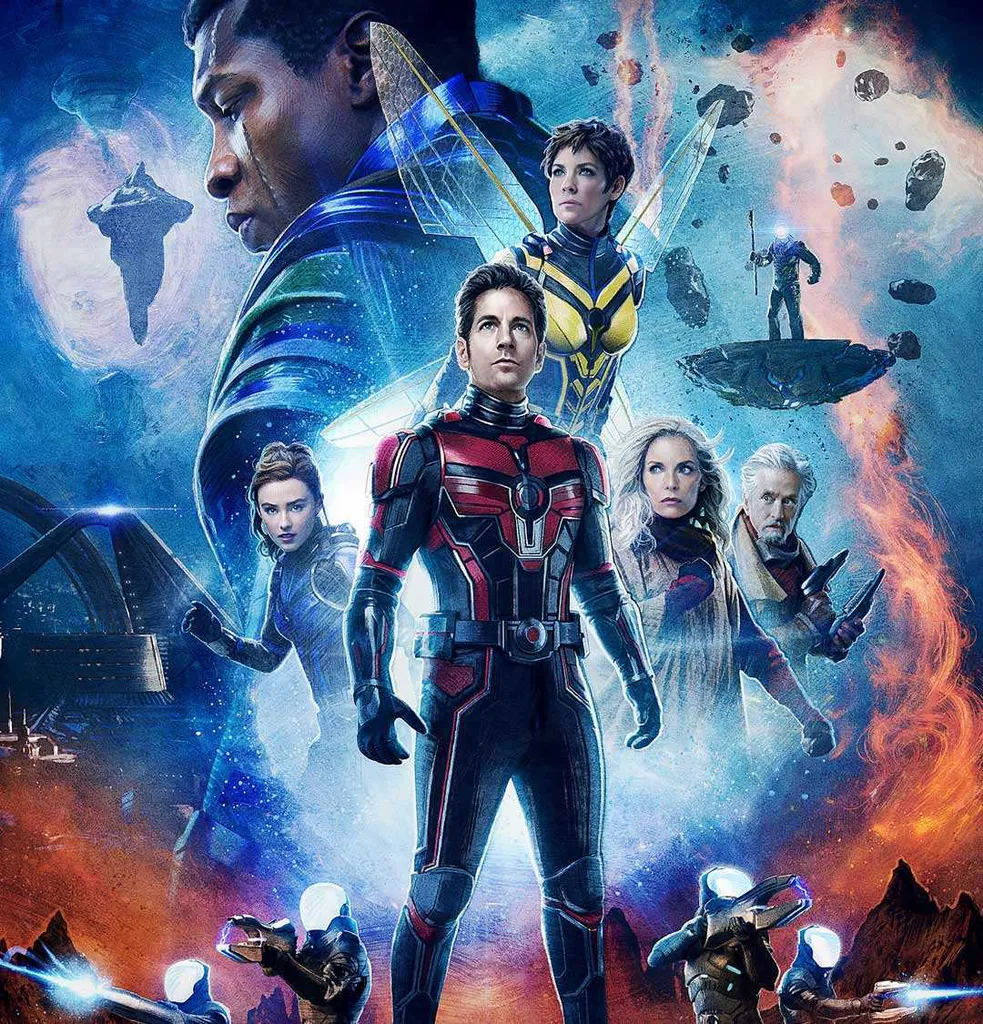- February 20, 2023
- By Chris Carroll
Is it truly dangerous to send a signal down to the quantum realm? And is that really the place to find pink, flying sea anemone-type creatures—and Bill Murray—in the new “Ant-Man and the Wasp: Quantumania”? The movie premiered on Friday, reaping an impressive $104 million in domestic ticket sales over the weekend—and quite possibly expanding the scientific horizons of millions of Marvel Comic Universe devotees. Uh, right?
These are some of the questions I saved up for the quantum physicist who attended the movie with me on opening day: Steve Rolston, chair of the University of Maryland Department of Physics and fellow of the Joint Quantum Institute (JQI).

He’s a leader of UMD’s broad quantum enterprise, which in partnership with the National Institute of Standards and Technology, forms one of world’s most influential concentrations of quantum science and technology research, featuring the JQI, the Quantum Technology Center and many others.
Rolston admitted in an email as we set up our outing that he’s interested in what legions of moviegoers are now soaking up about his field: “Not that I’m a Marvel fan, but since it has quantum in the title, I feel obligated to see it anyway:)”
So how did “Quantumania” do fact-wise? And is Rolston now a Marvel fan? Read on for his takeways.
“There wasn’t a lot of quantum in the ‘quantum realm.’”
Rolston made this point seconds after leaving the theater, dashing any hope that I might have just compensated for never taking an undergrad physics course. The film’s “quantum realm,” a phrase repeated nearly a dozen times in one early scene, is more like Frank Baum’s Oz—a place of wonderment, magic and strange creatures—than any of Stephen Hawking’s concepts. Its descriptions of quantum reality (mouthed by Michelle Pfeiffer’s original Wasp) as “a secret universe beneath our own” that is “outside time and space” are fantasy.
“It’s not a separate universe from ours,” Rolston said. “In some sense, we’re in the quantum realm right now.” Because quantum science deals with universe at the scale of atoms and photons, we can’t see it or directly experience it—part of why the adjective “quantum” likely carries such an exotic frisson—but it and its sometimes-counterintuitive physical rules are very real, and increasingly well understood. “At the heart it, everything we are and do goes back to the quantum realm,” Rolston says.

If we could shrink like Ant-Man, the world at quantum scale would not look like THAT.
Rolston admitted he was taken by the film’s eye-catching visual effects, which portrayed a marvelous variety of fantastic landscapes—Tatooine-like deserts; lush, “Avatar”-inspired forests; even a few “Finding Nemo”-esque settings. But: “Squishy and organic is not the way I would envision the quantum world,” he said. “As Wasp and her mom were discussing, I was disappointed they didn’t have pizza down there, too.”
Instead, he said, if you had access to the movie’s “Pym particles” and were able to shrink and look at a single atom, the volume of the nucleus plus electrons (which have no physical dimensions) would be infinitesimal; an atom is almost completely empty space: “A sterile, cold, nonorganic space … dark,” Rolston mused. “Not a funny place—which is maybe why I’m not a filmmaker, or at least a Marvel filmmaker.”
The movie missed some chances to intelligently play with quantum concepts.
When Ant-Man (Paul Rudd) and the Wasp (Evangeline Lilly) encounter a “probability storm” and meet their doubles, the movie seemed to be introducing “superposition,” Rolston said—a quantum effect crucial in quantum computer science and engineering. A particle in superposition can exist in two states at once, until the quantum system gets knocked out of whack or otherwise collapses into a single reality. Instead of exploring the concept, however, it took an action-packed but nonsensical route dictated entirely by visuals rather than ideas. Likewise, a plotline about the “multiverse”—a quantum mechanics-based theory that there are infinite, constantly branching universes that express every possible iteration of reality—is used purely as a fantasy device. “There’s no possibility of traveling between universes in the theory,” Rolston said.
Quantum scientists often care what the public thinks about the field.
“I’m interested in the popularization of things quantum, because I hope it spurs interest and helps advance it,” whether through increased research funding, more partnerships or talented students coming into the field, Rolston said (and he’s far from the only UMD quantum researcher seeing the movie).
At the same time, he said, many researchers in the field worry about overblown hopes leading to a so-called “quantum winter,” where money for research could freeze up if quantum computers or other devices don’t materialize fast enough for funders. Artificial intelligence research experienced just such a drop in activity in the early 1990s “AI winter.” “Optimism is good, but hype doesn’t help,” he said.
This movie isn’t quantum’s “Dead Poet’s Society”
You know those films that inspire kids to devote themselves to changing lives in the classroom, or become journalists to expose corrupt leaders, or train to profile cannibalistic killers? “Ant-Man and the Wasp: Quantumania” is unlikely to drive a wave of interest in exotic forms of physics, “but maybe someone will Google one of the terms they hear in the movie and get interested,” Rolston said.
Scientific accuracy aside, the first film he has seen in a theater since the pandemic started wasn’t ALL bad: “There were some funny, sardonic one-liners, and I thought they did a good job with the CGI,” he said. “Couldn’t have been cheap.”
But in the end: “It’s not my thing—all the noise and all the constant visual overstimulation.”
Translation: Another Marvel blockbuster.
